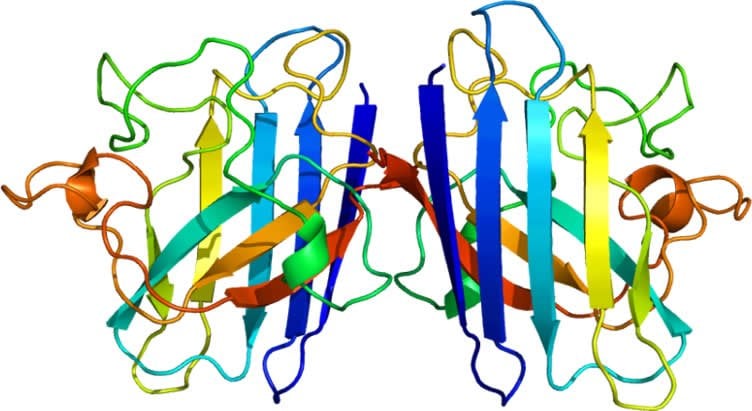Using a technique that illuminates subtle changes in individual proteins, chemistry researchers at Cornell have uncovered new insight into the underlying causes of Amyotrophic Lateral Sclerosis (ALS).
Brian Crane, professor of chemistry and chemical biology, led one study and co-authored a follow-up on a spectroscopic method that detects subtle changes to copper-containing proteins in solution. He and Jack Freed, the Frank and Robert Laughlin Professor of Physical Chemistry, have developed the method together with Petr Borbat, associate director of Cornell’s National Biomedical Center for Advanced ESR Technology.
The first study, which proved the principle of the technique – pulsed dipolar electron spin resonance (ESR) spectroscopy – was published Oct. 7 in Biophysical Journal; the second paper, which used the technique to connect ALS symptoms with protein aggregation, appeared Oct. 14 in Proceedings of the National Academy of Sciences (PNAS).
A complex neurodegenerative disease, ALS often has a genetic component – genetic defects that cause it can be inherited. Scientists have long known that one of the culprit genes codes for the protein “superoxide dismutase 1” or SOD1 – a critical copper-containing enzyme that protects cells against oxidative damage by destroying free radicals.

Scientists have surmised that ALS is a disease related to oxidative damage of neurons, and that might still be true, Crane said. But he and colleagues have provided strong evidence for another hypothesis: that SOD1 mutations cause ALS by destabilizing the SOD1 protein structure. This leads to increased motion of the proteins, which Crane likened to “breathing.” This movement promotes their aggregation, or clumping together – an event toxic to the healthy cell.
“ALS, in this form, appears to be a protein aggregation disease, much like Alzheimer’s and Parkinson’s diseases,” Crane said.
For a long time, people have studied mutations in SOD1 to try to understand ALS, but the properties of normal proteins and mutated ones were found to be very similar. By using ESR spectroscopy, the scientists for the first time have seen definitive differences. By verifying with other methods, Crane said, the researchers showed that the dynamics of the proteins were dramatically changed by mutation, and that they showed a tendency to aggregate.
In the PNAS paper, X-ray scattering was also used to study structural changes and the ability of the proteins to interact with each other. The researchers found that levels of protein aggregation correlated with the severity of ALS symptoms.
Their conclusions point to the possibility of ALS being more linked to toxicity of aggregation and perhaps less about the effect of the mutations on SOD1 activity, Crane said. ALS is a late-onset disease, with people being affected in mid to late life. “Sporadic mutations in SOD1 arise from natural processes, but it’s not really clear if they’re actually going to generate the disease or not,” he said.
The new ESR might be a good diagnostic tool to identify harmful mutations early before symptoms become evident, Crane said. These methods could also aid in the development of drugs that would bind to and stabilize the proteins to prevent detrimental effects in the first place.
The Biophysical Journal paper, “Copper-Based Pulsed Dipolar ESR Spectroscopy as a Probe of Protein Conformation Linked to Disease States,” was co-authored with Freed, Borbat, and first-author Gregory Merz, a graduate student in chemistry.
The PNAS paper, “Aggregation Propensities of Superoxide Dismutase G93 Hotspot Mutants Mirror ALS Clinical Phenotypes,” was authored in collaboration with the groups of Elizabeth Getzoff and John Tainer at the Scripps Research Institute. Crane and Freed’s research was supported by the National Institutes of Health.
Contact: Anne Ju – Cornell University
Source: Cornell University press release
Image Source: The image is credited to Emw and is licensed Creative Commons Attribution-Share Alike 3.0 Unported
Original Research: Abstract for “Aggregation propensities of superoxide dismutase G93 hotspot mutants mirror ALS clinical phenotypes” by Ashley J. Pratt, David S. Shin, Gregory E. Merz, Robert P. Rambo, W. Andrew Lancaster, Kevin N. Dyer, Peter P. Borbat, Farris L. Poole II, Michael W. W. Adams, Jack H. Freed, Brian R. Crane, John A. Tainer, and Elizabeth D. Getzoff in PNAS. Published online October 14 2014 doi:10.1073/pnas.1308531111
Abstract for “Copper-Based Pulsed Dipolar ESR Spectroscopy as a Probe of Protein Conformation Linked to Disease States” by Gregory E. Merz, Peter P. Borbat, Ashley J. Pratt, Elizabeth D. Getzoff, Jack H. Freed, and Brian R. Crane in Biophysical Journal. Published online October 7 2014 doi:10.1016/j.bpj.2014.07.068






